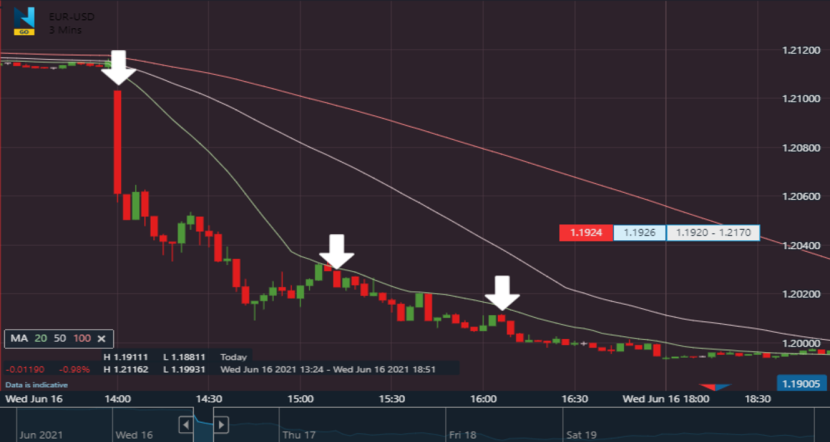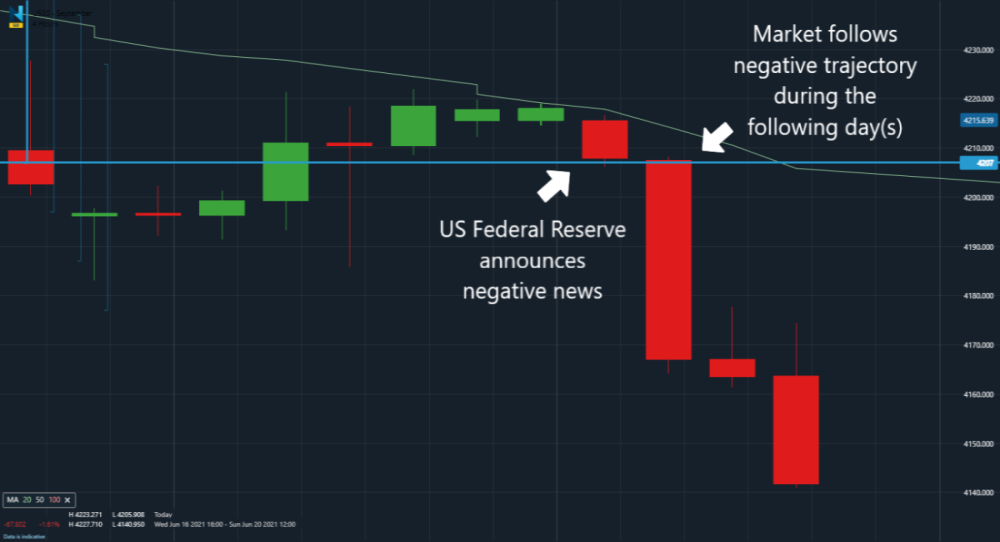
Interested in day trading? There are many day trading strategies to experiment with. Intraday trading may require focus and dedication, but it can be an exhilarating and rewarding way to approach your trading. All you have to do is find a strategy that suits your personality, your risk appetite, and the financial markets you’re interested in.
What is day trading?
Day trading is a trading style involving the buying and selling of financial instruments within a single trading day. This style of trading focuses on closing out positions at the end of each day and starting fresh the next (known as “going home flat”). Day traders buy and sell many assets multiple times within a day, taking advantage of small market movements.
Day trading involves making fast decisions and executing many trades for a relatively small profit each time. It can be seen as the opposite of most investment strategies, where you seek to benefit from price movements over a longer period.
To learn more, take a look at our helpful day trading beginners' guide.
Which strategy is best for day trading?
When finding the best day trading strategy, choose a strategy that works the best for you and not the one that seems to be the most popular. Your trading style is dependent on your personality, mindset, appetite for risk, and trading requirements. Successful day trading strategies that work for others may not work for you. However, day traders need to have a consistent strategy that combines technical and fundamental analysis to predict price movements.
Trend continuation trading
If you’re seeking a simple day trading strategy that works, consider trend continuation trading. With this strategy, day traders look for trends to plan their next moves. Here’s how you’d trade a trend continuation:
If a market is in an uptrend and you believe this will continue, you buy.
If a market is in a downtrend and you believe this will continue, you sell.
One way to implement this strategy is through a method called “breakout strategies,” where your entry and exit points work in tandem. Instead of looking for small gaps in the market, focus on larger ”breakaway” gaps exceeding your entry point or a percentage similar to said entry point – like 5%. In contrast, if you’re shorting an asset and it falls below your entry point threshold, you would enter the trade at this point.
Why do this? Well, as a market begins to trade outside of a price barrier, volatility tends to follow. This means prices will typically continue to trend in the current direction of the ”breakout.”
Indicators to help predict a continuation
Fibonacci retracements
These can help you identify potential levels of support and resistance. If there's a momentary dip, they can indicate when a trend may resume. They can also help you to set your profit targets.
Moving averages
Moving averages show you the average of previous candles, giving clues about where support and resistance levels may be and the trend direction.
Moving average convergence divergence (MACD)
Another type of moving average, the MACD, provides buy and sell signals.
Trend reversal trading
Trends have to reverse at some point. Day traders usually look for smaller dips in a trend over a short period, perhaps based on financial news or other market-moving events. You can also use indicators to help you decide when a trend reversal might be approaching.
Indicators to help predict a trend reversal
Relative strength index (RSI)
As a momentum indicator, the RSI can reveal oversold or overbought conditions, which can precede a trend reversal.
Fibonacci extensions
This enables you to see key levels of potential support and resistance, so you can decide if there could be a short-term dip.
Fibonacci retracements
These can help you spot potential short-term turning points, as shown by the percentages, which can provide key support and resistance levels.
This strategy is not recommended for beginners, as the aim of this is to trade against the trend. To do so, you need market expertise to action your trades successfully, as you are trading against the status quo. One such strategy is known as the daily pivot, which focuses on buying at the low of the day and selling at the high of the day.
Scalping
Scalping is the practice of taking small profits throughout the day. This trading strategy works very well for active day traders and is particularly popular with those trading the forex markets. Scalping focuses on minute-to-minute price changes, which are driven by quantity. As soon as the trade becomes profitable, you would exit the trade. There is no ”waiting for the market to depict trends,” as you will have to be quick and close trades that are losing money instantly. The more volatile the market, the better it is to employ scalping.
Our unique knock-out contracts can be great for scalping if you think there’s a lot of market volatility on the horizon. You can close your trades early if you want to take your profits, and the floor/ceiling structure will protect you if the trade doesn’t go your way.
Our five-minute binary options are also popular instruments for scalping. This is the shortest contract duration offered by Nadex, enabling you to find scalping opportunities even if there isn’t much movement in the markets.
You may want to use tear-off tickets when you’re scalping. With them, you can set up a position in the opposite direction so that you’re ready to exit, either taking your profits or limiting your losses.
Bear in mind that scalping can be risky if you’re placing multiple trades on a very short-term basis. It’s essential to manage your risk carefully.
Event-driven trading
Major corporate, economic, and political events can have an impact on markets. This simple day trading strategy focuses solely on taking advantage of these ‘events’. This is a popular trading strategy for those new to day trading, so if that’s you, read on!
News coverage of current events can influence the prices of forex pairs, stock indices, and commodities. This is not just speculation – many experienced traders will take advantage of this. You would normally wait until the market shows a consolidation pattern before an expected news release (like an earnings report) and then act as soon as a market breakout occurs.
Simply put, buy when positive news is announced and short when negative news comes out to implement this strategy.
Forex day trading strategy example
Using the moving averages indicator is one way of day trading forex markets. This can be done with two short-term moving averages and a much longer one to reveal the trend.
In the examples below, five-day and 20-day moving averages (MA) are used for the short term and a 200-day MA for the longer term on a three-minute EUR/USD chart.
In the first chart, the longer-term MA is moving up, so we look for the five-day MA to cross above the 20-day MA to enter positions in the direction of the trend, as indicated by the arrow.

In the second chart, the long-term MA is going down, so we look for short positions when the price crosses below the five-day MA, which has already crossed below the 20-day MA.

It's important to remember that these trades go with the trend and that we are not looking to try and catch every move.
Stock day trading strategy example
Imagine you are day trading stock indices using the event-driven strategy. When an announcement is made that moves an index where it closes the day at an extreme high or low, you would often see it moving in the same direction the next day.
Say you are trading the S&P 500 and during the day, the US Federal Reserve announces some negative news impacting the market in a significant way, as seen below:

At the end of the day, the market closes at an extreme low and you expect it to drop even further when it opens the following morning. You could then open a short position to take advantage of the anticipated decline.
Putting your day trading strategy into practice
Mastering day trading is no easy feat. With practice, determination and discipline, you will be able to improve your technique. By applying the techniques outlined above, you can develop a strategy and plan that works for you.
How? Practice day trading with a risk-free demo account until you feel confident enough to trade on live markets. It also helps to avoid markets you don’t understand, no matter how appealing they may be, until you have given yourself a chance to increase your trading knowledge. And do make use of technical and fundamental analysis to inform your trading decisions.
Day trading FAQs
Can you make a living off day trading?
To potentially make a living off day trading, it is important to have a solid trading strategy that incorporates analysis on reasonable returns to cover your living expenses. Keep in mind, you should have strong risk management and utilize multiple strategies that adjust for different market conditions.
Day trading can certainly be a career for many who have the discipline, tools, education, and keen understanding of their trading psychology and style. The best way to get started is with a free demo account to hone your skills and learn what products and markets best suit your day trading style.
How much do you need for day trading?
For most day traders in the US, the legal minimum balance required to day trade stocks is $25,000. This is known as the Pattern Day Trader (PDT) Rule. However, Nadex is exempt from the PDT Rule. Plus, you can open a live account for free - that's right, no minimum deposit required. The cost to place a trade is always equal to the maximum risk, plus any trade fees. Not ready for a live account? Try our free demo account.
Can you day trade more than three times a week?
Yes, you can day trade more than three times a week! A pattern day trader is a person who executes four or more trades over five business days and usually must follow the Pattern Day Trader (PDT) Rule. Nadex has no Pattern Day Trader Rule and offers thousands of contracts with durations from five minutes to a week. You can trade 23 hours a day, 5 days a week. Nadex is the home for day traders looking to capture short-term forex, stock indices, and commodity market volatility.
How do I become a day trader?
To become a day trader, you must put in the time to learn and practice trading the markets. Get started by reading a guide on day trading for beginners. Next, apply what you learned by practicing on a free demo account.
Nadex products are well-positioned for day trading. Binary options, knock-outs, and call spreads are available with various contract durations, giving you access to intraday opportunities with built-in risk. With our expert customer service team and learning center, Nadex can potentially help you reach your day trading goals at a pace that’s right for you.
Can day traders hold stocks overnight?
Day traders can hold stocks overnight, although this technically would not be considered a day trade. Nadex Binary Options and Knock-Outs have weekly contract durations on stock indices markets, so you are able to hold positions overnight. Trading hours on Nadex encompass what other exchanges call regular trading hours or the trading session — traditionally the time between the opening bell and the close — as well as after-hours trading.


 Back to Blog
Back to Blog